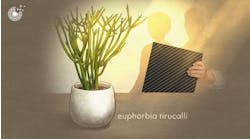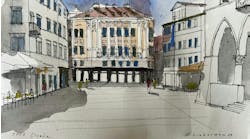Organized by the Istanbul Foundation for Culture and Arts (İKSV), Turkey’s contribution to the 1st London Design Biennale presents "The Wish Machine," a project undertaken by the Istanbul-based multidisciplinary design studio, Autoban. The inaugural London Design Biennale (running sept. 7-27) features projects from over thirty countries, which were called to respond to the theme of "Utopia by Design."
The Wish Machin’ project takes direct inspiration from the "wish-tree," a cultural tradition deeply rooted in the ancient Anatolian faith and found in ancient Greek, Kabala, and Persian beliefs. It operates on a simple mechanism that involves affixing a note or a memento to a branch of a tree as an act of hope. The Wish Machine takes this multi-cultural tradition as the key insight into how design and utopia can cooperate.
During the opening, the founders of Autoban Seyhan Özdemir and Sefer Çağlar; curatorial advisors, artist and communication advisor Paul McMillen, architect Zehra Uçar, Koleksiyon’s furniture designer and brand director Koray Malhan, and Director of Istanbul Design Biennale, Deniz Ova, were present to support the launch of The Wish Machine project presented today, Setp. 6 at the biennale.
İKSV Chairman Bülent Eczacıbaşı, Central Anatolian Exporters' Association Board Member Erdem Çenesiz and General Secretariat R&D Manager Sevgin Utlulığ on behalf of Turkishceramics Promotion Group attended the inauguration of Turkey’s exhibition. Designers, architects, academicians, art professionals and curators were also present at the opening.
The installation appears as an interactive pneumatic system operating in a mirrored space. Visitors are invited to walk through a tunnel made of transparent hexagonal tubes. They are invited to share their hopes and wishes, vision of utopias, and aspirations for the future, by writing them on paper, and feeding them to the Wish Machine through a lid. Notes will then travel back through the tubes to a place out of visitors’ sight. Just like throwing coins to the depths of a lake or lighting a candle to make a wish come true, the final destination will remain a mystery.
There’s a new reality of social movements and change in which Turkey is the epicenter by being a land bridge from the Middle East to Europe. Today, looking at the maps of migration, one can see the emergence of a new kind of wish-tree around Europe: not in the form of tying small notes to a tree, but manifested in the migration of populations searching for a utopian country as they flee war. It can be seen as an extreme utopic gesture, where the "Utopia" is developed and designed on the scale of an individual, sending their hopes to reach into the unknown.
In forming The Wish Machine, Seyhan Özdemir and Sefer Çağlar, the founders of Autoban, were motivated by the utopian idea of detaching from all known parameters belonging to the past and the present to dream for a better future. Their inspirations, reflected in their own field of design were a positively provocative approach to suggest solutions for humanity, and the act of dreaming. Having realized the preceding systems that were designed to create a perfect order from chaos and diversity have eventually failed, the designers embraced the endless journey both as a method and form. Utopia was an inspirational resource for the idea of "being triggered for searching." Throughout their journey, Utopia was a reference point that inspired them to create constructive thinking and keep the essence of hope.
Autoban has worked in an interdisciplinary and collective way with different expertise, to make a real, interactive, and perfectly working mechanical system, custom designed for the biennale space. In their design approach for the London Design Biennale, the company has looked into possibilities to express familiar traditions in new representations, and to build a century-long, well-known system with a surprising new form and function.
Turkey’s contribution to the biennale is located in the West Wing G1A at Somerset House, and realized with the kind contribution of the Republic of Turkey's Ministry of Culture and Tourism, and Turkish Embassy in London.


